
中国海洋湖沼学会主办。
文章信息
- 边莹, 刘星, 葛林科, 赫春香, 张蓬. 2017.
- BIAN Ying, LIU Xing, GE Lin-Ke, HE Chun-Xiang, ZHANG Peng. 2017.
- 利用半透膜渗透装置富集-超声萃取分析表层沉积物间隙水PCBs的方法
- ANALYTICAL METHOD OF COLLECTING POLYCHLORINATED BIPHENYLS (PCBs) IN PORE WATER OF SEDIMENTS USING SEMI-PERMEABLE MEMBRANE
- 海洋与湖沼, 48(4): 745-752
- Oceanologia et Limnologia Sinica, 48(4): 745-752.
- http://dx.doi.org/10.11693/hyhz20170100019
-
文章历史
- 收稿日期:2017-01-19
- 收修改稿日期:2017-04-06
2. 国家海洋局海洋生态与环境重点实验室 国家海洋环境监测中心 大连 116023
2. State Oceanic Administration Key Laboratory of Marine Ecology and Environment, National Marine Environment Monitoring Center, Dalian 116023, China
多氯联苯(PCBs)属于持久性有机污染物, 在全球范围内曾被广泛应用于工业品的制造。尽管在20世纪70年代被禁止使用, 但由于其具有持久性和累积性, 在环境中仍然可以检测到他的存在(Wu et al, 2011; Eqani et al, 2013; Combi et al, 2016)。海洋环境中的沉积物被认为是PCBs最主要的汇, 当PCBs从来源上不再产生时, 沉积物就成为周围环境中污染物的次级来源(Sobek et al, 2014)。对沉积物中有毒污染物进行客观的生态风险评估与管理需要准确预测污染物的生物有效性。传统的评估方法是基于沉积物中污染物的总浓度进行的, 这种方法可能过高地估计了污染物的生物有效性。若采用离心法分离出大量的间隙水进行含量测定, 得到的是间隙水中污染物的总量。考虑到生物有效性与间隙水中自由溶解态有机污染物的浓度密切相关, 故需要后续操作分离出溶解态的污染物。由于沉积物中间隙水的总量很少, 存在胶体和溶解有机碳, 以及污染物自身的低溶解度, 所以测定沉积物中可溶解态疏水性有机污染物的含量极为困难(Hawthorne et al, 2009; Ruus et al, 2010; Cui et al, 2013; Martinez et al, 2013)。
被动采样技术正是为解决上述问题而逐渐发展起来的。一些被动采样装置已被成功应用于水体中污染物的测定, 如硅橡胶片(silicone rubber)、聚甲醛(POM)、聚二甲基硅氧烷镀玻璃纤维膜(PDMS)和半透膜渗透装置(semi-permeable membrane device, SPMD)等(Cornelissen et al, 2008; Yates et al, 2013; Yılmaz et al, 2014; Lang et al, 2015; Wang et al, 2016)。SPMD只允许溶解态的污染物进入装置内, 因此直接富集的是间隙水中自由溶解态的污染物, 更能体现污染物的生物有效性, 且无需后续分离操作, 简单易行。相对于其他的被动采样器而言, SPMD已被标准化, 其结果具有可比性, 有利于数据归一化处理。但是目前SPMD应用于沉积物间隙水中的研究甚少, 仅见对沉积物间隙水中二噁英/呋喃、非共平面PCBs、多环芳烃和滴滴涕的报道, 这些研究证明其在沉积物间隙水中的适用性(Rantalainen et al, 2000; Zhu et al, 2001; Zhao et al, 2013)。常用的SPMD膜袋中PCBs的萃取-净化方法为有机溶剂透析法-复合层析柱法, 萃取时间长, 有机溶剂消耗量大, 且带来实验室安全隐患。
本研究拟建立超声萃取-凝胶渗透色谱净化-气相色谱法, 检测SPMD膜袋中PCBs的分析技术, 在实验室条件下将SPMD埋于取自大连湾海域的表层沉积物中, 通过分析SPMD装置内PCBs浓度, 以估计大连湾沉积物间隙水中27种自由溶解态PCBs的浓度。与沉积物中PCBs总量、间隙水中PCBs总量及用有机碳含量校正法得到的结果进行比较, 为考察该海域沉积物介质中不同子相间分布情况及进行沉积物风险评估提供了参考依据。
1 材料与方法 1.1 研究区域2015年9月使用抓斗式采样器采集辽宁省大连湾附近海域4个站位点(图 1)表层(0—5cm)沉积物, 用铝箔纸包好, 密封于聚乙烯袋中, 保存于冰箱中(-18℃)。实验时将取自4个站位的样品合并。
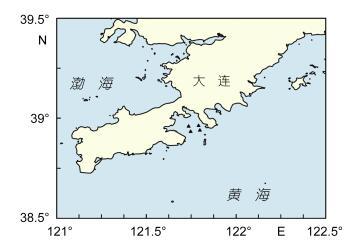 |
| 图 1 大连湾采样站位图 Fig. 1 The sample sites in Dalian Bay |
美国安捷伦7890A气相色谱仪(GC); 美国J2 Scientific凝胶渗透色谱; 瑞士Büchi R-215旋转蒸发仪; 美国Millipore Milli-Q超纯水仪; DLSB-5/10低温冷却循环泵; KQ-500DA型超声波清洗器。
低密度聚乙烯薄膜[50μm (厚度)×5cm (宽度), Australian Institute of Marine Science]; 三油酸甘油酯(triolein, 纯度99%, 北京百灵威科技有限公司); PCBs混标(C-WNN, 美国AccuStandard公司, 包括CB-8, 18, 28, 52, 44, 66, 101, 77, 81, 114, 118, 123, 153, 138, 126, 187, 167, 128, 156, 157, 180, 169, 170, 189, 195, 206, 209);实验中使用的正己烷、乙酸乙酯、环己烷均为液相色谱级, 购自美国Tedia公司; 其他试剂均为分析纯, 实验用水为超纯水。
1.3 实验方法 1.3.1 SPMD的制作根据标准SPMD的制作要求, 首先将低密度聚乙烯膜袋按15cm长度剪裁, 用超纯水清洗, 再用正己烷浸泡48h, 取出晾干, 内充330μL三油酸甘油酯, 用封口机密闭膜袋, 膜表面积与内加酯的体积比约为460cm2/mL。
1.3.2 SPMD法富集沉积物间隙水中的PCBs将沉积物样品放置于不锈钢容器中, 将SPMD膜袋均匀埋于沉积物中, 保证膜袋被2cm以上厚度的样品覆盖, 将容器静置于恒温箱中, 温度保持在(16±2)℃, 放置31天。取出膜袋, 依次用自来水和超纯水清洗并擦干。然后将膜袋置于80mL正己烷中, 超声萃取32min, 旋蒸浓缩至近干, 溶剂置换成体积比为1︰1的乙酸乙酯-环己烷混合溶液, 定容至5.0mL。取4.0mL上步实验得到的溶液, 按4.7mL/min的流速通过凝胶渗透色谱柱, 收集11—17min的流出液, 旋蒸至近干, 并用正己烷进行溶剂置换, 定容至1.0mL, 用于GC测定。
1.3.3 离心法提取沉积物间隙水中的PCBs取3500g沉积物均匀分装于40支离心管中, 以3000r/min转速离心30min, 收集上清液(约为600mL), 用0.45μm的玻璃纤维滤膜抽滤, 得到基本透明但略显土黄色的滤液。取500mL滤液置于分液漏斗中, 加入150mL正己烷萃取, 分离出正己烷相并旋蒸至近干, 定容至1.0mL, 用于GC测定。
1.3.4 沉积物中PCBs的提取和净化称取10g待测样、1g硅藻土和5g活化后的铜粉, 混匀后转入玻璃离心管中, 加入50mL 1︰1的正己烷-丙酮混合液, 超声40min, 以2000r/min转速离心5min, 将上清液转移至装有2%硫酸钠溶液的分液漏斗中, 充分振荡, 弃去下层的丙酮-水相; 加入浓硫酸30mL酸洗三次, 充分振荡, 弃去下层; 加入2%的硫酸钠进行水洗, 弃去下层, 重复洗涤至水相为中性(pH 7)。分离出正己烷相并旋蒸至约2mL。将旋蒸液通过硅胶柱净化(填料由上至下为无水硫酸钠、去活的中性氧化铝、硅胶), 用60mL正己烷淋洗, 收集淋洗液并旋蒸至近干, 用正己烷定容至1.0mL, 用于GC测定。
1.3.5 色谱条件PCBs测定按姚婷等(2014)的-GC法进行。DB-5MS毛细管气相色谱柱(30m×320μm, 0.25μm); 不分流的进样方式, 进样体积1μL, 进样口温度: 220℃; 载气为高纯氮气(纯度≥99.999%); 流速: 1.5mL/min; ECD检测器温度: 300℃; 升温程序如下:初始温度为80℃, 保持0min, 以20℃/min的速度升至180℃, 保持0min, 以5℃/min升至250℃, 保持2min, 以30℃/min升至280℃, 保持8min, 后运行2min, 总运行时间为30min。
1.3.6 沉积物特征参数测定沉积物中总有机碳(total organic carbon, TOC)含量采用重铬酸钾容量法(中华人民共和国国家质量监督检验检疫总局, 2003)测定。沉积物粒径采用李艳等(2014)的数据, 粒径: 2.0—7.2Φ, 平均粒径5.3Φ。含水率采用重量法测定(国家海洋局, 2008)。
1.3.7 质量控制和质量保证(QA/QC)配制浓度分别为1.0, 5.0, 10.0, 20.0, 50.0ng/mL的PCBs混合系列标准工作液, 经GC-ECD测定, 结果表明在上述范围内, 27种PCBs色谱峰的峰面积与浓度呈线性, 相关系数r的范围是0.9986—0.9995。27种PCBs的方法检出限为0.03— 0.12ng/g (三油酸甘油酯)。
整个样品分析过程均参考美国环保署(EPA)的QA/QC控制样监控方法进行质量控制和保证:对SPMD样品进行实验室空白和空白SPMD加标实验。间隙水样品采用实验室空白和空白基质加标作质控。沉积物样品进行实验室空白、空白基质加标。SPMD样品加标回收率分别为68.50%—121.73%;间隙水样品加标回收率为88.40%—110.03%。沉积物样品加标回收率为65.52%—103.10%。
2 结果与讨论 2.1 膜袋内PCBs萃取方法的优化在本实验中, 比较了超声萃取法(UE)和有机溶剂透析法(OSD)提取膜袋内PCBs的效果。制作尺寸为5cm (宽度) × 15cm (长度)的膜袋, 分别注入含有低、中、高三个浓度梯度(20, 100, 400ng/g三油酸甘油酯)的内充液。将每种浓度的膜袋平均分成两组, 分别用于超声萃取与有机溶剂透析实验, 每个浓度值有三个平行样。在两种方法中均采用正己烷作为萃取剂。对于5 × 15cm的膜袋, 参考Bustamante等(2013)的方法, 超声萃取法时用80mL正己烷超声32min; 有机溶剂透析法时选择80mL正己烷浸泡24h, 然后更换正己烷70mL浸泡6h, 合并两次萃取液。两种提取方法的回收率如图 2所示。由于CB-128和CB-167重叠, 因此只检出26种组分。对比两种方法的萃取率:当浓度为400ng/g时, 两种方法的回收率基本一致(65%—148%和58%—152%); 当浓度为100ng/g时, 26个组分的回收率均接近80%, 并且超声萃取结果均高于透析的结果。上述结果表明当PCBs的浓度较高时, 超声萃取法优于透析法。从不同回收率范围内测定值出现的几率这一角度对比两种方法:在70%—80%的较高回收率范围内, 超声萃取法在各个浓度水平时测定值出现的几率均高于透析法, 而透析法表现出明显优势的回收率区间是60%—70%, 这说明超声萃取法对于大多数分组的准确度要高于透析法。
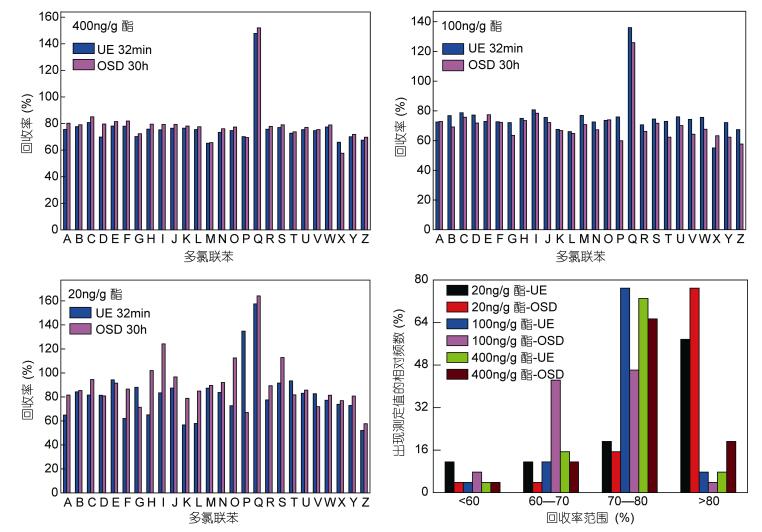 |
| 图 2 超声萃取法与有机溶剂透析法回收率的比较 Fig. 2 Comparison in the recovery between UE (ultrasonic extraction) and OSD (organic solvent dialysis) 注:图中A—Z分别表示CB-8、18、28、52、44、66、101、77、81、114、118、123、153、138、126、187、167、128、156、157、180、169、170、189、195、206、209;酯:三油酸甘油酯; UE:超声萃取法; OSD:有机溶剂透析法 |
综上所述, 相比于有机溶剂透析法, 超声萃取法具有消耗有机溶剂少、萃取时间短、回收率高等优点, 能提高分析准确度和实验效率, 减少环境污染。因此本研究选用超声萃取法提取SPMD中的PCBs。
2.2 GPC淋洗时间的选择以1︰1的乙酸乙酯-环己烷为溶剂, 配制各组分浓度均为32ng/mL的混标操作液, 取1.0mL进入凝胶色谱柱, 以1min为间隔, 分别收集6—18min的流出液, 检测每分钟流出液中PCBs的含量。结果表明在11—17min之内27种PCBs的回收率达到71%— 91%(图 3)。因此收集时间确定为11—17min。
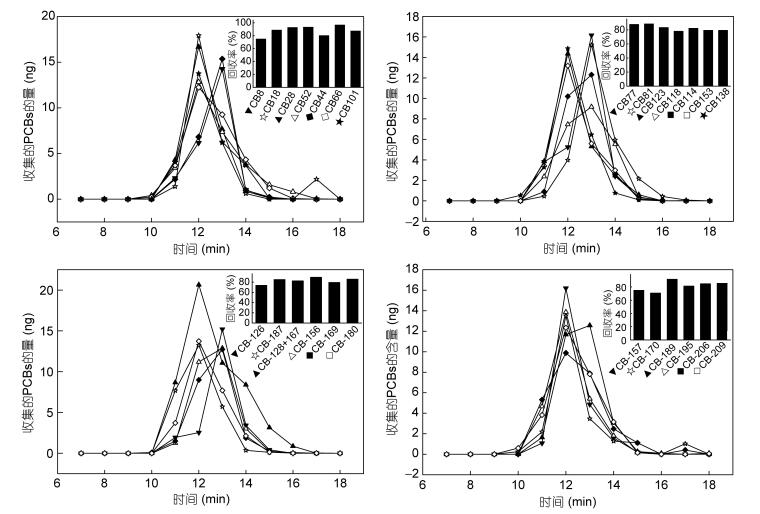 |
| 图 3 27种多氯联苯的流出曲线和回收率(内插图) Fig. 3 The elution profile and recoveries (inset) of 27 PCBs |
分别测定26和31天SPMD中PCBs的含量(N), 结果列于表 1。
| N (ng) | CW-SPMD(ng/L) | CSED(ng/g) | CW-SED(ng/L) | CPW(ng/L) | ||||
| 26天 | 31天 | 26天 | 31天 | |||||
| CB-18 | 2.11 | 2.60 | 0.013 | 0.015 | 0.14 | 0.72 | 8.58 | |
| CB-28 | 0.94 | 3.33 | 0.006 | 0.018 | 0.13 | 0.51 | 19.80 | |
| CB-52 | Nd | 1.96 | Nd | 0.010 | 0.20 | 0.59 | 3.83 | |
| CB-44 | 0.46 | 1.92 | 0.003 | 0.010 | 0.16 | 0.56 | 5.36 | |
| CB-66 | 0.40 | 0.29 | 0.002 | 0.001 | 0.23 | 0.28 | 14.00 | |
| CB-101 | 1.64 | 1.27 | 0.009 | 0.006 | 0.11 | 0.10 | 13.08 | |
| CB-77 | 2.28 | 3.50 | 0.013 | 0.017 | 0.63 | 0.82 | 11.12 | |
| CB-81 | 1.62 | 3.68 | 0.010 | 0.019 | 3.23 | 1.84 | 12.02 | |
| CB-123 | Nd | Nd | Nd | Nd | 0.25 | 0.15 | 9.21 | |
| CB-118 | 0.85 | 2.64 | 0.005 | 0.013 | 0.07 | 0.06 | 10.97 | |
| CB-114 | 0.26 | 0.56 | 0.002 | 0.003 | 0.75 | 0.49 | 9.50 | |
| CB-153 | 0.10 | 2.19 | 0.001 | 0.013 | 0.25 | 0.08 | 10.11 | |
| CB-138 | 0.40 | 0.58 | 0.002 | 0.003 | 0.27 | 0.20 | 8.09 | |
| CB-126 | 0.67 | 0.82 | 0.004 | 0.004 | 0.12 | 0.06 | 5.24 | |
| CB-187 | 2.75 | 1.91 | 0.018 | 0.011 | 0.38 | 0.13 | 4.89 | |
| CB-128+167 | 0.54 | 0.14 | 0.004 | 0.001 | 0.16 | 0.04 | 5.22 | |
| CB-156 | Nd | 0.61 | Nd | 0.003 | 0.35 | 0.14 | 3.25 | |
| CB-169 | 0.66 | 0.38 | 0.005 | 0.002 | 0.36 | 0.07 | 4.03 | |
| CB-180 | Nd | 2.14 | Nd | 0.011 | 0.05 | 0.03 | 2.97 | |
| CB-157 | Nd | Nd | Nd | Nd | 0.25 | 0.09 | 9.26 | |
| CB-170 | 0.98 | 0.22 | 0.007 | 0.001 | 0.22 | 0.06 | 2.57 | |
| CB-189 | Nd | Nd | Nd | Nd | Nd | Nd | Nd | |
| CB-195 | 5.13 | 7.91 | 0.037 | 0.049 | 0.11 | 0.02 | 0.54 | |
| CB-206 | 3.55 | 2.81 | 0.028 | 0.019 | 0.19 | 0.03 | 0.52 | |
| 注: N为SPMD中PCBs的含量, C W-SPMD为SPMD法计算的间隙水中自由溶解态PCBs浓度; CSED为沉积物中PCBs的含量, C W-SED为有机碳含量校正法计算的间隙水中PCBs浓度; CPW为离心法获得的间隙水中PCBs含量; Nd:未检出 | ||||||||
SPMD计算法计算间隙水中自由溶解态PCBs含量的依据是: Huckins等(2006)的理论模型, 可按公式(1) 计算间隙水中自由溶解态PCBs的浓度(CW-SPMD):
 (1)
(1)公式(1) 中, CW-SPMD是间隙水中自由溶解态PCBs浓度, N是SPMD中富集的PCBs的含量, VS是SPMD的体积, KSW是SPMD/水分配系数, 可按公式(2) 计算:
 (2)
(2)公式(2) 中, KOW为辛醇/水分配系数, 引自Yuan等(2016)文献。公式(1) 中Ri, j是暴露时间为j时化合物i的采集速率, Ri, j值按公式(3) 计算
 (3)
(3)计算Ri, j需要性能参考化合物(PRC)的采样速率RPRC, j, 参考Vrana等(2002)以D10-ANT作为PRC而计算出的采样速率为10.4L/d。式(3) 中, αPRC是一个性能参数, 我们参考Vrana的文献取值4.54, αi是特定化合物的影响参数(Booij et al, 2003; Fernandez et al, 2009), 可以按公式(4) 计算:
 (4)
(4)将N带入公式(1), 计算得到26天自由溶解态间隙水中27种污染物的浓度(CW-SPMD, 列于表 1)。结果表明: CB-52、CB-123、CB-156、CB-157、CB-180、CB-189未检出, 其他PCBs的浓度均在0.001—0.037ng/L之间; 31天的结果中, CB-123、CB-157、CB-189未检出, 其余均在0.001—0.049ng/L范围内(结果同列于表 1)。上述结果与文献报道结果的数量级相近(Booij et al, 2003; Tomaszewski et al, 2008; Hawthorne et al, 2011; Allan et al, 2012; Charrasse et al, 2014)。
有机碳含量校正法的结果是根据沉积物中PCBs的含量计算获得的。按实验方法首先测定了沉积物中PCBs的含量(CSED), 结果表明27种PCBs的含量在0.05—3.23ng/g之间(表 1)。与文献报道的其他地区值相比, 大连湾表层沉积物中PCBs的含量尚属较低水平, 近似于辽东湾沉积物含量水平(nd—3.7ng/g), 低于胶州湾(10.39—22.26ng/g)、南非伊丽莎白港(0.56—2.35ng/g)和钦州湾(0.23—6.26ng/g), 远低于中国珠江口(11.54—485.45ng/g), 高于厦门湾( < 0.01—0.32ng/g) (Kang et al, 2000; Zhou et al, 2000; 刘文新等, 2005; 郭军辉等, 2011; 李源媛等, 2013; Kampire et al, 2015)。按实验方法, 测定了沉积物样品中有机碳的含量(fOC), 结果为3.97%。参考Gschwend等(2011)文献, 根据测得的沉积物中污染物的浓度和样品TOC含量, 可按下式计算间隙水中PCBs的浓度(CW-SED):
 (5)
(5) (6)
(6)公式(5) 中, CSED是沉积物中污染物的浓度, fOC是有机碳含量, KOC是沉积物有机碳/水分配系数或吸附系数, 参考Karickhoff等(1981)文献按式(6) 计算, KOW值引自Yuan等(2016)文献。
将CSED代入式(5), 计算得到27种PCBs的含量(CW-SED), 结果同列于表 1。发现27种PCBs的含量在0.02—1.84ng/L范围之间。
采用离心法获得的间隙水中PCBs含量(CPW)同列于表 1。结果表明27种PCBs的含量在0.52— 19.80ng/L之间。
三种方法得到的间隙水中PCBs含量的对比如图 4所示。通过比较可以看出, 离心法得到的间隙水总量(CPW)最高, 比用有机碳含量推算出的间隙水含量(CW-SED)高1—2个数量级, 通过SPMD计算的间隙水含量(CW-SPMD)最低, 比CPW低3—4个数量级。
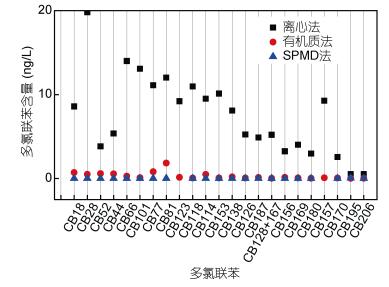 |
| 图 4 三种方法得到的PCBs浓度的比较 Fig. 4 Comparison of concentrations calculated for PCBs by three methods |
离心法得到的是沉积物间隙水中PCBs的总量, 包括与胶体、有机碳结合态和溶解态, 因此测定结果最高。而通过SPMD得到的是间隙水中PCBs总量的一部分, 因此含量偏低。比较两种不同的理论模型(有机碳含量法和SPMD法)估算得到的间隙水中PCBs的含量, 发现CW-SED比CW-SPMD高1—2个数量级, 可能的原因是:有机碳含量校正法仅考虑了有机碳对污染物的影响, 却忽略了黑碳等其他碳质的作用, 低估了KOC值, 使得测定结果较高(Ribeiro et al, 2008; Obst et al, 2011; Karacık et al, 2013)。根据Booij等(2006)、Verweij等(2004)和Echols等(2000)的报道, 分析SPMD与贝类、鱼类等生物监测结果(图 5), 发现PCBs在SPMD中的含量与在生物体内含量(Cm)接近, 其比值(CSPMD/Cm)落在0.1—1.5范围内的频数超过76%, 证明了二者监测结果呈现较好的一致性。因此, 根据SPMD富集结果估计间隙水中自由溶解态污染物浓度的方法, 可以排除与胶体和溶解态有机碳结合的污染物的干扰, 比通过有机碳含量校正法从沉积物中推算的数据能更准确地表达污染物的生物可利用性, 进而表明SPMD在表达生物有效性领域具有较好的应用前景。
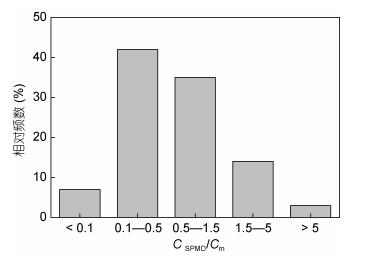 |
| 图 5 SPMD和贝类中PCBs含量比值(CSPMD/Cm)在不同区间内出现的相对频数 Fig. 5 The relative frequency of CSPMD/Cm values for SPMD and mussel at some different intervals |
本文比较了超声萃取法和有机溶剂透析法对SPMD中PCBs的提取效果, 超声萃取法在节省时间和溶剂方面有明显优势; 确定了凝胶渗透色谱净化的收集时间为11—17min; 建立了半透膜渗透装置富集-超声萃取-凝胶渗透色谱(GPC)净化-气相色谱(GC-ECD)测定(SPMD)膜带中多氯联苯(PCBs)的分析方法。
分别比较了用离心法、SPMD和有机碳含量校正法估计大连湾沉积物间隙水中PCBs含量的结果。SPMD法计算得到沉积物间隙水中自由溶解态污染物的浓度, 该值被认为能体现污染物的生物有效性, 本实验测定值为未来沉积物风险评价提供参考数据基础。
| 中华人民共和国国家质量监督检验检疫总局, 2003. GB/T 19145-2003沉积岩中总有机碳的测定. 北京: 中国标准出版社, |
| 刘文新, 陈江麟, 林秀梅, 2005. 渤海表层沉积物中DDTs、PCBs及酞酸酯的空间分布特征. 环境科学学报, 25(1): 58–63 |
| 李艳, 刘艳, 李安春, 等, 2014. 大连湾附近海域表层沉积物粒度特征及水动力环境指示. 海洋通报, 33(5): 552–558 DOI:10.11840/j.issn.1001-6392.2014.05.010 |
| 李源媛, 王英辉, 李平阳, 等, 2013. 钦州湾表层沉积物中多氯联苯的分布特征及风险评价. 海洋环境科学, 32(5): 698–701 |
| 国家海洋局, 2008. GB 17378-2007海洋监测规范. 北京: 中国标准出版社, |
| 姚婷, 张蓬, 赫春香, 2014. 大连湾和杭州湾表层沉积物中多氯联苯和有机氯农药及风险评价. 海洋科学, 38(7): 47–56 DOI:10.11759/hykx20130728001 |
| 郭军辉, 殷月芬, 郑立, 等, 2011. 胶州湾东岸表层沉积物中多氯联苯的分布特征及风险评价. 农业环境科学学报, 30(5): 965–972 |
| Allan I J, Ruus A, Schaanning M T, et al, 2012. Measuring nonpolar organic contaminant partitioning in three Norwegian sediments using polyethylene passive samplers. Science of the Total Environment, 423: 125–131 DOI:10.1016/j.scitotenv.2012.02.027 |
| Booij K, Hoedemaker J R, Bakker J F, 2003. Dissolved PCBs, PAHs, and HCB in pore waters and overlying waters of contaminated harbor sediments. Environmental Science & Technology, 37(18): 4213–4220 |
| Booij K, Smedes F, Van Weerlee E M, et al, 2006. Environmental monitoring of hydrophobic organic contaminants:the case of mussels versus semipermeable membrane devices. Environmental Science & Technology, 40(12): 3893–3900 |
| Bustamante J, Navarro P, Arana G, et al, 2013. Ultrasound assisted dialysis of semi-permeable membrane devices for the simultaneous analysis of a wide number of persistent organic pollutants. Talanta, 114: 32–37 DOI:10.1016/j.talanta.2013.03.076 |
| Charrasse B, Tixier C, Hennebert P, et al, 2014. Polyethylene passive samplers to determine sediment-pore water distribution coefficients of persistent organic pollutants in five heavily contaminated dredged sediments. Science of the Total Environment, 472: 1172–1178 DOI:10.1016/j.scitotenv.2013.10.125 |
| Combi T, Miserocchi S, Langone L, et al, 2016. Polychlorinated biphenyls (PCBs) in sediments from the western Adriatic Sea:Sources, historical trends and inventories. Science of the Total Environment, 562: 580–587 DOI:10.1016/j.scitotenv.2016.04.086 |
| Cornelissen G, Arp H P H, Pettersen A, et al, 2008. Assessing PAH and PCB emissions from the relocation of harbour sediments using equilibrium passive samplers. Chemosphere, 72(10): 1581–1587 DOI:10.1016/j.chemosphere.2008.04.041 |
| Cui X Y, Mayer P, Gan J, 2013. Methods to assess bioavailability of hydrophobic organic contaminants:Principles, operations, and limitations. Environmental Pollution, 172: 223–234 DOI:10.1016/j.envpol.2012.09.013 |
| Echols K R, Gale W R, Schwartz T R, et al, 2000. Comparing polychlorinated biphenyl concentrations and patterns in the Saginaw River using sediment, caged fish, and semipermeable membrane devices. Environmental Science & Technology, 34(19): 4095–4102 |
| Eqani S A M A S, Malik R N, Cincinelli A, et al, 2013. Uptake of organochlorine pesticides (OCPs) and polychlorinated biphenyls (PCBs) by river water fish:The case of River Chenab. Science of the Total Environment, 450-451: 83–91 DOI:10.1016/j.scitotenv.2013.01.052 |
| Fernandez L A, Harvey C F, Gschwend P M, 2009. Using performance reference compounds in polyethylene passive samplers to deduce sediment porewater concentrations for numerous target chemicals. Environmental Science & Technology, 43(23): 8888–8894 |
| Gschwend P M, Macfarlane J K, Reible D D, et al, 2011. Comparison of polymeric samplers for accurately assessing PCBs in pore waters. Environmental Toxicology and Chemistry, 30(6): 1288–1296 DOI:10.1002/etc.v30.6 |
| Hawthorne S B, Grabanski C B, Miller D J, 2009. Solid-phase-microextraction measurement of 62 polychlorinated biphenyl congeners in milliliter sediment pore water samples and determination of KDOC values. Analytical Chemistry, 81(16): 6936–6943 DOI:10.1021/ac901001j |
| Hawthorne S B, Grabanski C B, Miller D J, et al, 2011. Improving predictability of sediment-porewater partitioning models using trends observed with PCB-contaminated field sediments. Environmental Science & Technology, 45(17): 7365–7371 |
| Huckins J N, Booij K, Petty J D, 2006. Monitors of Organic Chemicals in the Environment:Semipermeable Membrane Devices. New York: Springer, |
| Kampire E, Rubidge G, Adams J B, 2015. Distribution of polychlorinated biphenyl residues in sediments and blue mussels (Mytilus galloprovincialis) from Port Elizabeth Harbour, South Africa. Marine Pollution Bulletin, 91(1): 173–179 DOI:10.1016/j.marpolbul.2014.12.008 |
| Kang Y H, Sheng G Y, Fu J M, et al, 2000. Polychlorinated biphenyls in surface sediments from the Pearl River Delta and Macau. Marine Pollution Bulletin, 40(9): 794–797 DOI:10.1016/S0025-326X(00)00089-8 |
| Karacık B, Okay O S, Henkelmann B, et al, 2013. Water concentrations of PAH, PCB and OCP by using semipermeable membrane devices and sediments. Marine Pollution Bulletin, 70(1-2): 258–265 DOI:10.1016/j.marpolbul.2013.02.031 |
| Karickhoff S W, 1981. Semi-empirical estimation of sorption of hydrophobic pollutants on natural sediments and soils. Chemosphere, 10(8): 833–846 DOI:10.1016/0045-6535(81)90083-7 |
| Lang S C, Hursthouse A, Mayer P, et al, 2015. Equilibrium passive sampling as a tool to study polycyclic aromatic hydrocarbons in Baltic Sea sediment pore-water systems. Marine Pollution Bulletin, 101(1): 296–303 DOI:10.1016/j.marpolbul.2015.10.069 |
| Martinez A, O'Sullivan C, Reible D, et al, 2013. Sediment pore water distribution coefficients of PCB congeners in enriched black carbon sediment. Environmental Pollution, 182: 357–363 DOI:10.1016/j.envpol.2013.07.015 |
| Obst M, Grathwohl P, Kappler A, et al, 2011. Quantitative high-resolution mapping of phenanthrene sorption to Black Carbon particles. Environmental Science & Technology, 45(17): 7314–7322 |
| Rantalainen A L, Cretney W J, Ikonomou M G, 2000. Uptake rates of semipermeable membrane devices (SPMDs) for PCDDs, PCDFs and PCBs in water and sediment. Chemosphere, 40(2): 147–158 DOI:10.1016/S0045-6535(99)00220-9 |
| Ribeiro L G L, Carreira R S, Wagener A L R, 2008. Black carbon contents and distribution in sediments from the southeastern Brazilian coast (Guanabara Bay). Journal of the Brazilian Chemical Society, 19(7): 1277–1283 DOI:10.1590/S0103-50532008000700008 |
| Ruus A, Bøyum O, Grung M, et al, 2010. Bioavailability of PAHs in aluminum smelter affected sediments:evaluation through assessment of pore water concentrations and in vivo bioaccumulation. Environmental Science & Technology, 44(24): 9291–9297 |
| Sobek A, Gustafsson Ö, 2014. Deep water masses and sediments are main compartments for polychlorinated biphenyls in the Arctic Ocean. Environmental Science & Technology, 48(12): 6719–6725 |
| Tomaszewski J E, Luthy R G, 2008. Field deployment of polyethylene devices to measure PCB concentrations in pore water of contaminated sediment. Environmental Science & Technology, 42(16): 6086–6091 |
| Verweij F, Booij K, Satumalay K, et al, 2004. Assessment of bioavailable PAH, PCB and OCP concentrations in water, using semipermeable membrane devices (SPMDs), sediments and caged carp. Chemosphere, 54(11): 1675–1689 DOI:10.1016/j.chemosphere.2003.10.002 |
| Vrana B, Schüürmann G, 2002. Calibrating the uptake kinetics of semipermeable membrane devices in water:impact of hydrodynamics. Environmental Science & Technology, 36(2): 290–296 |
| Wang J X, Bi Y H, Henkelmann B, et al, 2016. PAHs and PCBs accumulated by SPMD-based virtual organisms and feral fish in Three Gorges Reservoir, China. Science of the Total Environment, 542: 899–907 DOI:10.1016/j.scitotenv.2015.10.134 |
| Wu S, Xia X H, Yang L Y, et al, 2011. Distribution, source and risk assessment of polychlorinated biphenyls (PCBs) in urban soils of Beijing, China. Chemosphere, 82(5): 732–738 DOI:10.1016/j.chemosphere.2010.10.090 |
| Yates K, Pollard P, Davies I, et al, 2013. Silicone rubber passive samplers for measuring pore water and exchangeable concentrations of polycyclic aromatic hydrocarbons concentrations in sediments. Science of the Total Environment, 463-464: 988–996 DOI:10.1016/j.scitotenv.2013.06.035 |
| Yılmaz A, Karacık B, Henkelmann B, et al, 2014. Use of passive samplers in pollution monitoring:A numerical approach for marinas. Environment International, 73: 85–93 DOI:10.1016/j.envint.2014.07.013 |
| Yuan J T, Yu S L, Zhang T, et al, 2016. QSPR models for predicting generator-column-derived octanol/water and octanol/air partition coefficients of polychlorinated biphenyls. Ecotoxicology and Environmental Safety, 128: 171–180 DOI:10.1016/j.ecoenv.2016.02.022 |
| Zhao Z H, Zhang L, Wu J L, et al, 2013. Application of semipermeable membrane devices (SPMDs) and benthic mussels to evaluate the bioavailability of sediment-associated DDTs. Soil and Sediment Contamination:An International Journal, 22(3): 351–364 DOI:10.1080/15320383.2013.726297 |
| Zhou J L, Hong H, Zhang Z, et al, 2000. Multi-phase distribution of organic micropollutants in Xiamen Harbour, China. Water Research, 34(7): 2132–2150 DOI:10.1016/S0043-1354(99)00360-7 |
| Zhu Y X, Zhang Y, Zhang J, et al, 2001. Monitoring polynuclear aromatic hydrocarbons in sediment porewater by SPMD. Chinese Journal of Oceanology and Limnology, 19(4): 382–388 DOI:10.1007/BF02850744 |
 2017, Vol. 48
2017, Vol. 48


